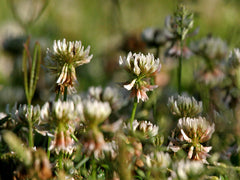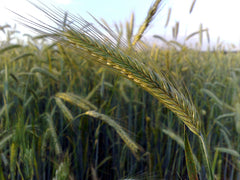Fracking forage radish
Raphanus sativusSOWING
Forage radish is commonly drilled or broadcasted in the fall, August to September. Radishes grow best when planted early enough to allow 6 weeks of growth before regular frosts. Later-planted radishes tend to be more cold-hardy and less likely to winter-kill. When planted in the spring, most radishes bolt quickly producing much less root and shoot biomass than fall plantings.Drilling a monoculture stand is best achieved with a small seeder box. When using a precision planter, milo plates may be used with a reduced seeding rate of 2-4 lbs per acre. Full canopy closure is possible to achieve within 3-4 weeks after planting.
UNDER SOW
Many producers broadcast radish into soybeans at leaf yellowing or corn when the canopy allows 50% of the sunlight to reach the ground. It is important that the seedlings quickly have access to light.
SPACING
There is growing Interest in planting radishes on wider 30” row spacings, often in combination with other cover crop species. This can be accomplished by blocking off rows in a drill or using a planter with appropriate plates or another seed metering system appropriate for radish seed.
WINTER HARDINESS
Radishes are tolerant of light frosts but generally show injury when temperatures drop below the mid-20s. In regions where winter temperatures regularly drop below 20 F, radishes normally winterkill but it should be noted that overwintering was reported at some northern locations in 2010 and 2012, likely due to early and persistent snowcover and unusually mild winter conditions, respectively. Young radishes in the rosette growth stage are more winter hardy than radishes that have developed a sizable storage root.
SHIPPING COST
25-lb., 50-lb. and larger sizes ship via ground transportation. Select the appropriate Bulk Shipping option at checkout. We may email you additional shipping costs separately based on your total order weight, zone and palleting costs.
Days from maturity calculated from the date of seeding. Average 7,000–8000 seeds per pound. Sow average of 6 lbs per acre drilling, sow 8–10 lbs per acre broadcast. Organic systems should plant 1/3 to 1/2 heavier to allow for some weed pressures. Usual seed life: 5 years. Isolation distance for seed saving: 1/2 mile.
Planting Depth 1/2” to 1”
Soil Temp. Germ. 45-80˚F
Days to Germ. 3–7
Plant Spacing 6–9.5”
Row Spacing 8-12”
Days To Maturity 120–150
Full Shade, Moist Well Drained
Fracking Seed Count
1 Pound ≈ 26,682 seeds
5 Pounds ≈ 133m seeds
25 Pounds ≈ 667m seeds
50 Pounds ≈ 1,334m seeds
- 250 Seeds$3.50
Fracking Daikon Radish is a deep rooted forage radish that will make an outstanding winter cover crop. The deep taproot of the Fracking Radish can help break up the tough, compacted soil, improve water infiltration, suppresses weeds, eliminate pests and stores nitrogen.
• Reduces soil compaction
• High B...
Fracking Daikon Radish is a deep rooted forage radish that will make an outstanding winter cover crop. The deep taproot of the Fracking Radish can help break up the tough, compacted soil, improve water infiltration, suppresses weeds, eliminate pests and stores nitrogen.
• Reduces soil compaction
• High Biomass production
• Increases water infiltration
• Excellent Erosion Control
• Great weed suppression
• Fast establishment
The radish attribute that has captured the most farmer interest is their robust rooting ability. Under favorable growing conditions, radish roots can extend more than 3 feet deep in 60 days, with the thickened storage portion of the root extending more than 12 inches. Plants with roots more than 1“ in diameter normally have a significant portion of the root exposed above ground, often more than 4”, even in uncompacted soils.
After radishes winter-kill and their large fleshy roots desiccate, the channels created by the roots tend to remain open at the soil surface, improving infiltration, surface drainage, and soil warming. Radish rooting effects on soil porosity also extend into the subsoil. This general process called bio-drilling, can improve root growth by subsequent crops and access to subsoil moisture resulting in greater resilience under drought conditions. Radish holes after winter kill. Research at the University of Maryland has shown that radish roots have greater ability to penetrate compacted soil than cereal rye and rapeseed. Subsequent research found twice as many corn roots penetrated compacted subsoil after radish cover cropping as compared to cereal rye, with both cover crops promoting more rooting than bare-fallow. These results suggest that radishes may be useful as a biological alternative to deep ripping and other mechanical methods of alleviating soil compaction, thus reducing fuel use.
When radishes begin to decay in the warming early spring, the decomposition emits a foul rotten-egg like smell. If radishes are planted in the spring then you can expect reduced root growth, slower development and seed production will cause a weed threat. Avoid adding to much radish seed to a mix because of its rapid growth, competition issues could occur with other species. Just add 2 lbs per acre of radish seed into a drilled mix.
A good stand of radishes can eliminate nearly all weed growth both during and for some time after active radish growth. To obtain near-complete weed suppression, radishes should be planted early (6 or more weeks before frost), at a relatively high population (more than 5 plants per square foot) into a clean seed bed. Weed suppression from fall planted radishes typically lasts into April, but does not extend much into the summer cropping season.
Unlike cereal rye and other small grains whose residues decompose slowly and continue to immobilize N for an extended period, radish residues decompose and release nitrogen rapidly. Timely crop establishment following radishes can result in an early boost in growth and nitrogen uptake similar to following a legume cover crop or nitrogen fertilizer application. In contrast, if planting is delayed (e.g., northern locations) and weather/soil conditions are conducive to leaching or denitrification (removing nitrates), the availability of nitrogen scavenged by radishes to subsequent crops may be limited.
Tags: Color: White, Specialty: Cover Crop, Season: Spring Fall Winter.Most of the forage radish varieties currently marketed for cover cropping are large rooted selections of daikon-type oilseed or forage radishes, but are not the product of formal breeding programs. All are morphologically similar to the large white daikon radishes traditionally used in Asian cooking. Hybrid daikon-type culinary radish seed is prohibitively expensive, more than $100 per lb for bulk seed, for use in cover cropping, but open pollinated culinary daikon varieties have some potential with bulk seed available for about $5 per lb.









